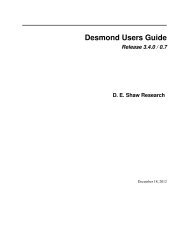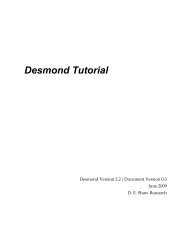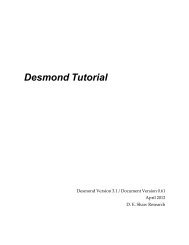Desmond Tutorial
Desmond Tutorial - DE Shaw Research
Desmond Tutorial - DE Shaw Research
- No tags were found...
Create successful ePaper yourself
Turn your PDF publications into a flip-book with our unique Google optimized e-Paper software.
Preparing Free Energy Perturbation<br />
Setting Up an FEP Calculation<br />
Figure 7.4 Defining the mutation<br />
The attachment bond is<br />
shown as a green arrow in<br />
the Workspace. The arrow<br />
should point from the<br />
core to the substitution<br />
group.<br />
NOTE<br />
NOTE<br />
3. Define the mutation to be performed by selecting the fragment(s) that will replace the<br />
substitution group from the Fragment Library. For this example, select the butyl row<br />
from the list of fragments. The selected row is highlighted in yellow as shown in<br />
Figure 7.3.<br />
You can apply multiple mutants at a time by using CTRL‐click and SHIFT‐click to<br />
select the mutants from the Fragment Library. When you select multiple fragments, FEP<br />
simulation creates different systems for each mutant, and runs multiple thermodynamic<br />
cycles to compute, respectively, the binding free energy difference between the<br />
reference ligand and each of the selected mutants, with respect to the receptor.<br />
You can also create arbitrary groups rather than selecting mutations from the Fragment<br />
Library. See “Creating a Custom Fragment Group” on page 80 for details.<br />
4. Click the green Start button. FEP simulation starts execution.<br />
<strong>Desmond</strong> uses Bennettʹs acceptance ratio method for FEP calculations, which means that<br />
numerous independent simulations will be run for a single FEP calculation. Since the<br />
independent simulations can be run simultaneously, you should be careful as to how<br />
many simulations can be allowed to run on your host/queue at the same time. You can<br />
control this parameter in the green Start window by setting the maximum number of subjobs<br />
as shown in Figure 7.5. The value zero means no limit.<br />
September 2008 D. E. Shaw Research 73






